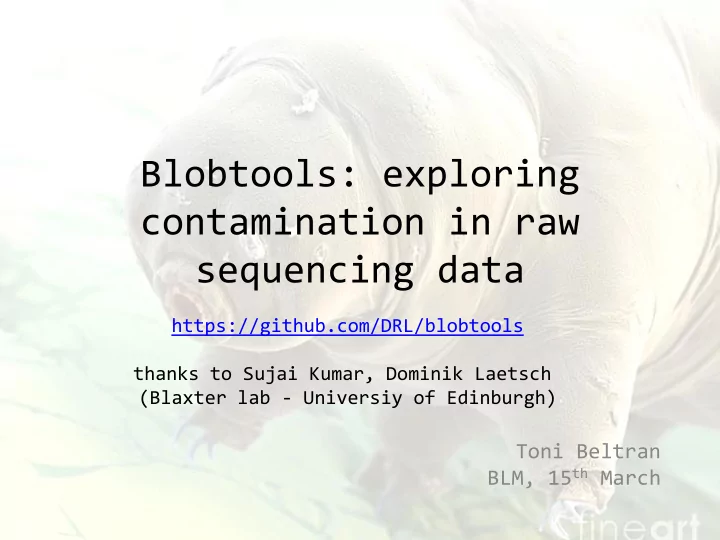

Blobtools: exploring contamination in raw sequencing data https://github.com/DRL/blobtools thanks to Sujai Kumar, Dominik Laetsch (Blaxter lab - Universiy of Edinburgh) Toni Beltran BLM, 15 th March
Genome assembly is an attempt to accurately represent an entire genome sequence from a large set of very short DNA sequences
Genome assembly is an attempt to accurately represent an entire genome sequence from a large set of very short DNA sequences
“A tremendous amount of genome analysis is built upon the framework of the DNA sequence itself: not only are genes and regulatory sites anchored in the sequence, but analyses of synteny , duplications and evolutionary relationships among species all depend on having the correct structure of the genome. We need to devote more effort to making sure the basis for all these analyses does not turn out to be a house of cards.” Salzberg and Yorke, 2005.
“A tremendous amount of genome analysis is built upon the framework of the DNA sequence itself: not only are genes and regulatory sites anchored in the sequence, but analyses of synteny , duplications and evolutionary relationships among species all depend on having the correct structure of the genome. We need to devote more effort to making sure the basis for all these analyses does not turn out to be a house of cards.” Salzberg and Yorke, 2005. With the democratisation of sequencing technologies, this is more relevant now than ever .
Genome assembly is a hard problem: Repeats Polymorphism Sequencing errors and biases Computational requirements Contamination
Genome assembly is a hard problem: Repeats Polymorphism Sequencing errors and biases Computational requirements Contamination
Contamination in sequencing datasets Small target organisms: need to pool several individuals Sequencing data will include “food” and sy mbiotic microbiota Contaminant contigs will interfere with downstream analysis Contaminants can compromise the assembly of the target genome
Wha t is a “blob plot”? Taxonomic Proxy of Caenorhabditis sp 38 annotation in molarity in colour the input DNA The size of the blob represents the length of the contig Proxy for species membership
How to make a “blob plot”
Blobplot.stats.txt
Blobplot.txt
Remove contaminant reads If we can identify the contaminants directly, and they have been sequenced, remove reads mapping to their genomes. If not, filter contigs based on GC content, coverage and taxonomic information. -Remove reads mapping to those contigs -Reassemble until no contaminant contigs are found
Remove contaminant reads If we can identify the contaminants directly, and they have been sequenced, remove reads mapping to their genomes. If not, filter contigs based on GC content, coverage and taxonomic information. -Remove reads mapping to those contigs -Reassemble until no contaminant contigs are found
E. coli Enterobacter Pseudomonas
“Genome sequencing, direct confirmation of physical linkage, and phylogenetic analysis revealed that a large fraction of the H. dujardini genome is derived from diverse bacteria as well as plants, fungi, and Archaea. We estimate that approximately one-sixth of tardigrade genes entered by HGT , nearly double the fraction found in the most extreme cases of HGT into animals known to date.”
UNC raw sequencing data shows lots of contigs with low/no coverage Koutsovoulos et. al. 2016
Edinburgh independent sequencing shows lots of contigs with low/no coverage Koutsovoulos et. al. 2016
Contigs with low coverage are not represented in independent RNA-seq data Koutsovoulos et. al. 2016
You should regard every draft genome assembly as work in progress. In some years time we will look back at genome assembly at this time with embarrassment – but this is the best we can do now. We should be more strict evaluating genome assembly quality. Check contamination even in published genome assemblies! There are reasons to be optimistic (long read technologies, single chromosome sequencing, Hi- C). Open science is fast and effective.
Recommend
More recommend